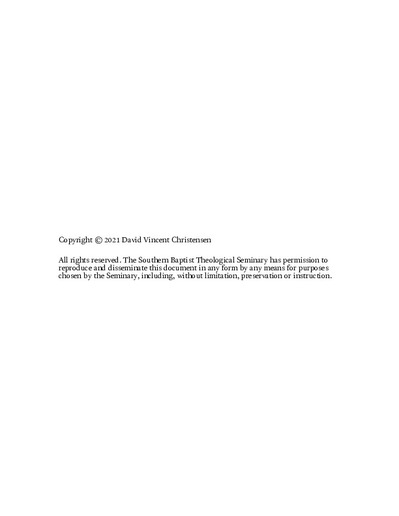| dc.contributor.advisor | Cook, William F., III | |
| dc.contributor.author | Christensen, David Vincent | |
| dc.date.accessioned | 2021-11-15T21:07:25Z | |
| dc.date.available | 2021-11-15T21:07:25Z | |
| dc.date.issued | 2021-11-13 | |
| dc.identifier.uri | https://hdl.handle.net/10392/6644 | |
| dc.description.abstract | Amidst the veritable flood of material written concerning the gospel of John, interpreters have written comparatively little concerning John's use of new exodus imagery. George Balentine's 1962 article, The Death of Jesus as a New Exodus, may be one of the only works to explicitly aim to connect the use of new exodus imagery with the death of Jesus; however, it spans all four gospels, and Balentine's treatment of Jesus' death in John focuses primarily on the three Passover cycles and paschal imagery. Therefore, a full-length study is needed to investigate the significance of John's use of exodus typology to describe Jesus' death. In this study, I contend that when John presents Jesus' death with exodus typology, he characterizes Jesus as the substitutionary sacrifice of the new exodus. If John's presentation of Jesus' death via exodus typology characterizes Jesus as the substitutionary sacrifice of the new exodus, then substitutionary atonement is essential to the inner mechanism of Jesus' death in the Gospel of John. | en_US |
| dc.subject.lcsh | Bible. John--Criticism, interpretation, etc. | en_US |
| dc.subject.lcsh | Atonement--Biblical teaching | |
| dc.subject.lcsh | Exodus, The--Typology | en_US |
| dc.title | The Lamblike Servant: Exodus Typology and the Death of Jesus in the Gospel of John | en_US |
| dc.type | Text | |
| dc.type | Electronic dissertation | en_US |
| dc.contributor.committee | Plummer, Robert L. | |
| dc.contributor.committee | Wellum, Stephen J. | |
| dc.contributor.committee | Caneday, Ardel B. | |
| dc.type.qualificationname | Ph.D. | en_US |
| dc.publisher.institution | Southern Baptist Theological Seminary | en_US |
| dc.publisher.department | School of Theology | |

